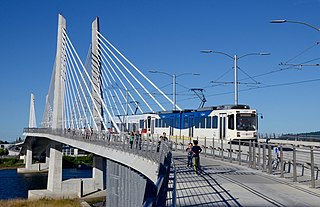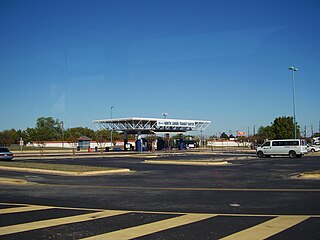
The MAX Green Line is a light rail service in Portland, Oregon, United States, operated by TriMet as part of the MAX Light Rail system. It is 15 miles (24.1 km) long and serves 30 stations from the PSU South stations to Clackamas Town Center Transit Center; it connects Portland State University (PSU), Portland City Center, Northeast Portland, Southeast Portland, and Clackamas. The Green Line is the only service that shares parts of its route with the four other MAX services, sharing the Portland Transit Mall with the Orange and Yellow lines and the Banfield segment of the Eastside MAX with the Blue and Red lines. Southbound from Gateway/Northeast 99th Avenue Transit Center, it operates the Interstate 205 (I-205) segment through to Clackamas Town Center. Service runs for approximately 211⁄2 hours daily with a headway of 15 minutes during most of the day. It is the third-busiest line in the system, carrying an average of 19,160 riders per day on weekdays in September 2019.

The MAX Orange Line is a light rail line serving the Portland metropolitan area in the U.S. state of Oregon. Operated by TriMet as part of the MAX Light Rail system, it connects Portland City Center, Portland State University (PSU), Southeast Portland, Milwaukie, and Oak Grove. The line serves 17 stations and runs for 201⁄2 hours per day with headways of up to 15 minutes. It averaged 3,480 daily weekday riders in September 2020.
The Capital Metropolitan Transportation Authority, officially stylized as CapMetro, is a public transportation provider located in Austin, Texas. It operates bus, paratransit services and a hybrid rail system known as CapMetro Rail in Austin and several suburbs in Travis and Williamson counties. In 2022, the system had a ridership of 21,145,300, or about 80,900 per weekday as of the third quarter of 2023.

The Southwest LRT is an under–construction 14.5-mile (23.3 km) light rail transit corridor in Hennepin County, Minnesota, with service between Minneapolis and Eden Prairie. The estimated one-way travel time from Southwest Station in Eden Prairie to Target Field Station in Minneapolis is 32 minutes. The Southwest LRT will extend through St. Louis Park, Hopkins and Minnetonka along the route. Major locations on the line will include Bde Maka Ska, Cedar Lake, the Walker Art Center, the Minneapolis Sculpture Garden and Target Field in downtown Minneapolis.

CapMetro Rail is a hybrid rail system that serves the Greater Austin area in Texas and is owned by CapMetro, Austin's primary public transportation provider. The Red Line is CapMetro's first and currently only rail line, and connects Downtown Austin with Austin's northwestern suburbs. The line operates on 32 miles (51 km) of existing freight tracks, and serves nine stations. After a series of delays, CapMetro Rail was inaugurated in March 2010. CapMetro added Friday evening and Saturday afternoon and evening regularly scheduled service on March 23, 2012. In 2022, the line had a ridership of 466,800, or about 1,500 per weekday as of the third quarter of 2023.

The Regional Connector Transit Project constructed a 1.9-mile (3.1 km) light rail tunnel for the Los Angeles Metro Rail system in Downtown Los Angeles. It connected the A and E lines with the former L Line. The A and E lines previously both terminated at 7th Street/Metro Center station, coming from Long Beach and Santa Monica, respectively, while the L Line ran through Little Tokyo/Arts District to either Azusa or East Los Angeles. Now the A and E lines continue together through new stations at Grand Avenue Arts/Bunker Hill, Historic Broadway, and Little Tokyo/Arts District. From there, they diverge on the former L Line toward Azusa and East Los Angeles, respectively. The project provides a one-seat ride into the core of Downtown for passengers on those lines who previously needed to transfer, thus reducing or altogether eliminating many transfers of passengers traveling across the region via Downtown Los Angeles.

Crestview station is a CapMetro Rail hybrid rail station and CapMetro Rapid bus rapid transit station in Austin, Texas. It is at the edge of the Crestview neighborhood of North Austin, at the corner of Airport Boulevard and North Lamar Boulevard. The North Lamar Transit Center is one mile (1.6 km) north of the station, and the Highland Mall Transit Center is 1⁄2 mile (0.8 km) to the southeast. There is no on-site parking at the Crestview station. Riders must park at the North Lamar Transit center and take buses 1 or 801 south to the train. With Project Connect, the Blue and Orange Lines will have a connection to this station.

Metro is a transit network in Minnesota serving the cities of Minneapolis and Saint Paul. It also provides service to some suburban areas. As of 2022, the system consists of two light rail lines and five bus rapid transit (BRT) lines all of which are operated by the local public transit company: Metro Transit. The five lines connect Downtown Minneapolis and St Paul with the Bloomington, Minneapolis-St Paul International Airport, Roseville, Richfield, Burnsville and Brooklyn Center.

CapMetro Rapid is a bus rapid transit service in Austin, Texas, owned and operated by the Capital Metropolitan Transportation Authority (CapMetro). It currently consists of two routes which run north-south served by stations designed by McKinney York Architects.
The Southeast Gateway Line, formerly the West Santa Ana Branch Transit Corridor, is a planned light rail line, mostly following the Pacific Electric's historic West Santa Ana Branch, connecting Downtown Los Angeles to the city of Artesia, along with other cities in southeastern Los Angeles County.

The Eastside Transit Corridor is a light rail line extension that currently connects Downtown Los Angeles with East Los Angeles. However, the extension is planned to extend further southeast to connect with the Gateway Cities, continuing from a relocated Atlantic station southeast to a new Lambert station in Whittier.

The K Line Northern Extension Project, formerly known as the Crenshaw Northern Extension Project, is a project planning a Los Angeles Metro Rail light rail transit corridor extension connecting Expo/Crenshaw station to Hollywood/Highland station in Hollywood. The corridor is a fully underground, north-south route along mostly densely populated areas on the western side of the Los Angeles Basin; it would be operated as part of the K Line. The Los Angeles County Metropolitan Transportation Authority (Metro) is prioritizing the project along with pressure from the West Hollywood residents. Construction is slated to start in 2041 and begin service by 2047 unless means to accelerate the project are found.
The history of the Los Angeles Metro Rail and Busway system begins in the early 1970s, when the traffic-choked region began planning a rapid transit system. The first dedicated busway opened along I-10 in 1973, and the region's first light rail line, the Blue Line opened in 1990. Today the system includes over 160 miles (260 km) of heavy rail, light rail, and bus rapid transit lines, with multiple new lines under construction as of 2019.
The Blue Line is a planned light rail line for connecting Austin–Bergstrom International Airport with downtown Austin, Texas. It is still in the planning stages as a part of CapMetro's Project Connect. It is estimated to begin revenue service as early as 2029.

Project Connect is a transit expansion program by the Capital Metropolitan Transportation Authority (CapMetro) in Austin, Texas, U.S. The program was approved by voters on November 3, 2020, in a local election concurrent with the 2020 presidential election.

D2 Subway is a proposed 2.4 mi (3.9 km) expansion of the DART Light Rail system in metropolitan Dallas, Texas, in the United States. The subway would run from the existing Victory station, tunneling underground through the city centre of downtown Dallas, and connect to the existing tunnel under Cityplace. Four new stations would be built along the new alignment.
The Gold Line is a proposed transitway for connecting North Central Austin and the Downtown's Eastside to South Austin. It is in the planning stages as a part of Capital Metro's Project Connect. According to the plan, the line will be initially be operated as a bus rapid transit line prior to future conversion to light rail. It is estimated to open in 2024.
The Green Line is a proposed commuter rail line for connecting the Northeast Austin area of Colony Park with the downtown Austin, Texas area in the United States. It is still in the planning stages as a part of CapMetro's Project Connect.

North Lamar Transit Center is a Capital Metropolitan Transportation Authority bus station in Austin, Texas. It is located on North Lamar Boulevard on the north side of U.S. Route 183. The station features a park and ride lot and is served by several local bus routes as well as CapMetro Rapid Route 801. As part of Project Connect, a CapMetro Rail light rail station is planned to be built at the facility; it is planned to be the northern terminus of the system.
The Downtown Transit Tunnel was a planned light rail tunnel in Downtown Austin, Texas. It was a core feature of the proposed initial investment of Project Connect, the transit expansion plan being undertaken by the Capital Metropolitan Transportation Authority. The transit tunnel would have served the Orange, Blue, and (eventually) Gold light rail lines. The tunnel was eventually cut from Project Connect plans after unexpected cost increases and design challenges.













